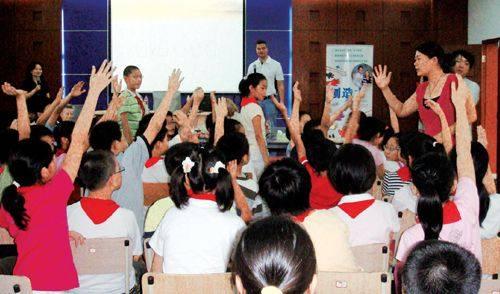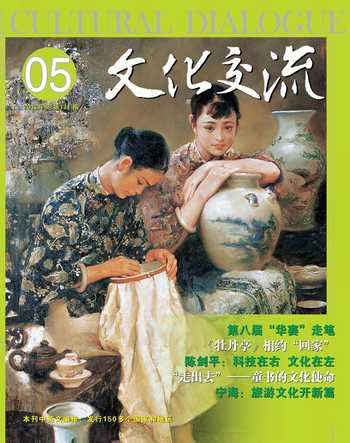“走出去”
2012-04-29朱凤娟
朱凤娟


2012年伦敦书展4月16日在伦敦伯爵宫会展中心开幕。伦敦书展,是仅次于德国法兰克福书展的世界第二大国际图书交易会。本届书展上,浙江出版联合集团主办“中国当代儿童插画展暨中国绘本图书展”。浙江少年儿童出版社特地赶制了10种“中国原创绘本系列”,展出并列入“中国国际经典出版工程”项目的英语版“绘本中国故事”和法语版《熊亮绘本系列》。这两种图书是浙少社分别与美国海马出版社、法国东方书局合作出版的。书中采用水墨水彩插画,不仅表现出儿童心灵世界的奇幻与瑰丽,而且向世界展现了中国文化的迷人魅力。
少儿出版是目前版权贸易非常活跃的出版领域,但是和成人图书出版一样,版权贸易上的巨大“逆差”一直是中国少儿出版界的重要话题,虽然近些年随着少儿出版的发展,富有远见的少儿社在努力推介优质图书“走出去”,但优秀原创作品真正融入世界范围的阅读依旧任重道远。
《文化交流》杂志继今年第三期刊发《徐海荣践行“文化走出去”》一文之后,本期关于“文化‘走出去‘引进来”话题的专访嘉宾是浙江少年儿童出版社副社长孙建江。
记者:孙社长,您好。在来之前,我大致了解了一下浙江少儿出版社,发现它2003年至2009年连续7年保持了全国少儿读物市场占有率第一,而且其中令人诧异的是,它基本不出版教辅类书册,这是怎么做到的呢?
孙建江:我们浙江少年儿童出版社成立于1983年,是一家以少年儿童为主要服务对象的专业出版社。现在全国有30多家专业少儿出版社,在570多家出版社中有520多家也都在出版少儿图书,所以竞争非常激烈。对于一个出版社来说,选题结构或者说图书产品结构是至关重要的。选题结构关乎出版社的市场定位、早期获益和后续发展。好的选题结构一定是可抗风险的、前瞻性的和具有市场竞争力的。
浙少社之所以能连续7年保持童书市场占有率第一,这和我们有一个较为合理的选题结构有关。比如,我们在实施“整体推进,重点突破”战略时,需要有百科工具书选题布局,但既有的编辑条件又不允许我们自己来做这类书,这时版权贸易就为我们提供了极大的便利,我们及时从日本小学馆引进了《最新21世纪少年儿童百科》,从英国DK引进了《最新21世纪中学生科学百科》,从英国马歇尔引进了《最新21世纪动物百科》等。
记者:除了合理的选题结构之外,我们知道浙少社在进口图书品牌运作方面的独具匠心也是一大优势,能否为我们介绍一些经典的案例?
孙建江:比如,我们自2001年开始引进奥地利畅销书作家托马斯·布热齐纳的《冒险小虎队》系列,历经“超级版”、“超级成长版”、“奇幻女生版”和“升级版”不断补充、修订和维护,至2010年,已累计出书60册,总销量近3000万册,销售码洋逾3亿元,成了中国最为知名的超级畅销童书品牌。而且,该系列的推出,还催生并引发了国内带工具互动式阅读的热潮。
再比如,我们从2007年开始引进德国绘本大师雅诺什的《睡鼠的睡梦时光》等四册绘本,投入市场后反响良好。次年,我们以“绘本博物馆”为品牌,大规模进入绘本领域,仅“绘本博物馆”中“大师经典”这个子系列,到目前就已推出了雅诺什、大卫·威斯纳、约翰·席斯卡和兰史密斯、露丝·布朗、托尼·罗斯等经典绘本图书近二十册。再加上“绘本博物馆”中“小书虫”、“我爱我家”等子系列的同时推出,我社绘本图书开始发力,“绘本博物馆”品牌赢得了更多读者的喜爱和认可。绘本图书板块成为了新的利润增长点。
记者:无论从销售量还是影响力来看,应该说进口图书都已成为浙少社非常重要的一部分,您能否为我们介绍一下,这几年浙少社在版权贸易引进和输出方面的情况?
孙建江:1990年至2010年,浙少社版权贸易方面引进和输出的年均比大约为1.7:1,即引进1.7种书,输出1种书。与我国图书版权贸易引进和输出年均6.5:1相比,浙少社1.7:1的图书版权贸易引进和输出比例,远远高出了全国的平均值,应该说情况还是比较理想的。
但如果从版权引进地及数量和版权输出地及数量对比看,两者间呈明显的错位现象,即我们引进的版权大多集中在欧美和日本等发达国家,而输出的版权大多集中在我国台港地区及东南亚汉文化圈。浙少社也只是到2007年,才开始将版权输出到欧美等发达国家,而且相比同等国家的版权引进,数量上呈明显逆差。
要改变这一错位现象,当然不是一朝一夕的事。这受到综合国力、强势文化及出版社自身实力等等因素的制约。但我们有信心搭乘中华文化全面复兴的“航母”迎头赶上。如果说早期的版权贸易多少还带些点缀、装饰和“完成任务”性质的话,那么如今的版权贸易,对于我們来说,早已置换为实实在在的、看得见的、融入整个出版产业链的自觉行为了。
记者:当然信心很重要,可是行动更重要。大家很想了解,在版权贸易输出方面,浙少社做了哪些有益的探索,可否分享一下经验?
孙建江:在图书输出领域,我们最大的体会是如何变惯常的国内作者——国内图书制作——国外版权输出,为国外作者——国内(或国外)图书制作——国外版权输出,和如何变单纯的图书版权输出为双方(或多方)共同打造的由单纯图书衍生出的文化产品。《创造力——孩子成长的第一要素》即是我们在这方面的一个尝试。
2006年,我们开始策划“创造力”这个项目。是年,芬兰作者吉姆和碧雅·索拉迪尔夫妇来访,双方谈及合作“创造力”项目一拍即合。我们选择吉姆和碧雅·索拉迪尔,是因为,教育是作者所在国芬兰最成功的出口产品。在芬兰的教育体系中,创造力是这个“智胜”小国的关键词。
吉姆和碧雅·索拉迪尔夫妇是芬兰知名的尼尔市场调查公司的创始股东和合伙人。吉姆曾担任芬兰市场研究协会主席,还担任欧洲民意和市场研究协会的芬兰代表。20年来,夫妇俩致力于创造力培训工作,帮助如雀巢、阿斯利康制药、阿拉乳品等一流国际公司成功应对了艰巨的商业挑战。选择芬兰作者吉姆和碧雅·索拉迪尔,我们当然也看中了图书产品推向欧美市场的前景;而吉姆和碧雅·索拉迪尔选择我们,是因为,中国是巨大的文化产品市场,浙少社是全国一流的优秀出版社,不仅国内声誉卓显,而且在国际上也有一定的知名度。
《创造力》策划的灵感来自一个由芬兰儿童合作创作的童话故事。几个芬兰孩子在旅行中,想象了一只小狗的形象,随后的旅行过程就成了那只小狗的历险,并由那只小狗生发出了一个小狗的星球……被童话打动之余,那些童话创作过程中所体现的经科学培训而得的素质,让我社编辑有感而发,将未来的书名确定为“创造力”。
为了让图书的内容更贴近中国市场,2007年,我们请来作者和部分芬兰孩子在杭州专门举办了一次“头脑风暴训练营”。主要目的是对书中提及的培养方案进行市场验证。训练营效果相当正面,吉姆夫妇也收获颇多。作者在对中国孩子较深入了解的基础上,及时调整了图书的内容,收入了许多具有中国特色的例证,例如曹冲称象、司马光砸缸等中国智慧故事。在这本书的结尾,作者还适时附录了中芬两国孩子运用创造力训练共同创作的一个童话故事。这些在后来图书版权输出芬兰的时候,起到了意想不到的文化融合作用。
记者:我们欣喜地看到浙少社的这种有益探索,开拓了图书从单纯的平面出版向立体综合型发展的模式,那么接下来对这种模式还有没有实践性的延伸呢?
孙建江:2010年,浙少社和芬兰未来编码公司、杭州师范大学初等教育学院、杭州普达海文化有限公司初步达成“创造力”文化产品深度开发意向。由浙少社牵头,以芬兰未来编码公司为国际平台,依托杭州师范大学初等教育学院学术资源,由杭州重点动漫文化企业普达海文化有限公司提供主要培训基地,进行有关“创造力”的人员培训(师资、学生、家长)和图书出版物及其衍生产品(教具、玩具等)开发、制作和销售。同时,杭州师范大学初等教育学院和浙少社积极接洽,计划申报相关课题,成立“中芬创造力培训中心”,将国际教育界领先的创造力培训方案以及配套相关资料整理出版。杭州普达海文化有限公司决定和浙少社进一步深入合作,复制《骨头城的阴影》动画片的制作模式:由创造力培训营的活动切入,让孩子们创造自己的故事,请国内或国际知名动画编剧进行深加工,国内制作动画片,兼顾海外市场发行,并将动画片的衍生产品的生产计划纳入其创意生活馆的项目。
記者:这些计划听起来让人很是振奋。您个人多年从事文化出版行业,也直接参与浙少社的“童书走出去”项目,就个人来说,您对我们少儿出版行业的“文化‘走出去‘引进来”寄予什么样的希望呢?
孙建江:开放的中国需要融入世界,世界需要认识中国。别具特色的现代中国儿童文学需要走向世界,世界不同肤色的儿童也需要认识和感受中国儿童文学。现在已经有越来越多的人认识到,童书版权输出,事关国家文化的世界影响力。我们要深入研究国外受众阅读需求和接受习惯,运用国外读者看得懂、易接受的方式,认真进行对外出版选题认证、策划,从而提高出版物的吸引力感召力;同时要进一步拓展对外交流合作的渠道和途径,增强“走出去”的营销能力,努力扩大受众范围,争取更多读者。把“图书走出去”的步子迈得更稳些、更大些。图书“走出去”的路径有很多条。但无论有多少条路径,有一点可以确信,那就是——适合自己的,才是最好的。□
嘉宾简介:
孙建江,男,浙江少年儿童出版社副社长、编审。浙江师范大学兼职教授、云南大学客座教授、中国作家协会会员。著有《二十世纪中国儿童文学导论》《童话艺术空间论》《飞翔的灵魂——解读安徒生的童话世界》《童年的文化坐标》等学术论著八种,《美食家狩猎》等作品集三十余种。
Go International: Mission of Chinese Childrens Books
By Zhu Fengjuan
The 2012 March issue of Cultural Dialogue ran a story on Xu Hairong, a Hangzhou-based publisher who held lec-tures on Chinese culture at UC Berkeley. The publisher is a pioneer on the mission of taking Chinese culture overseas. In or-der to see how Chinese publishers bring in overseas culture to Chinese readers and take Chinese books to international young readers, I recently interviewed Sun Jian-jiang, vice president of Zhejiang Juvenile & Childrens Publishing House, on the topic of Chinese books going international. The following is a gist of the interview.
The Zhejiang Juvenile & Childrens Publishing House, founded in 1983, is spe-cialized in publishing books for children. Nowadays competition for young readers is fierce as 30 some childrens publishing houses competing against each other for the love of young readers and their parents. Moreover, 520 of 570 some publishers in China produce books for children. Zhejiang Juvenile & Childrens Publishing House was Chinas biggest publisher of childrens books for seven consecutive years from 2003 to 2009 in terms of market share. It accomplished the mission impossible without publishing a single textbook. The secret of the success was the well-balanced structure of the books it published. During these years, it reprinted three sets of ency-clopedias, one by a Japanese publisher and the other two by British publishers.
Zhejiang Juvenile & Childrens Publish-ing House is well known for publishing foreign books for Chinese young readers. Since 2001, the publisher has been intro-ducing the “The Knickerbocker Gang” by Thomas Brezina, an Austrian writer of chil-drens books. By 2010, the publisher had published 60 titles in Brezinas bestseller series. The sales volume of the 60 books was more than 300 million yuan. This is one of many writers the publisher has intro-duced. These foreign books add up to a new growth point for this publisher.
Zhejiang Juvenile & Childrens Pub-lishing House plays a high-profile role in introducing Chinese childrens books to international young readers. From 1990 to 2010, the publisher bought copyrights for books from overseas publishers and sold copyrights to overseas publishers in the proportion of 1.7 to 1. In other words, the publisher printed 1.7 books from overseas publishers for every book it sold to foreign publisher. The national average was a rate of 6.5 to 1. Sun Jianjiang is not particularly satisfied with the copyright trade. For many years, the publisher bought copyrights largely from publishers in Europe, America and Japan while sold copyrights to publish-ers in Taiwan, Hong Kong and countries in Southeast Asia. It was not until 2007 that the publisher was able to sell copyrights to publishers of the west.
It takes time for Chinese publishers to sell copyrights to foreign publishers. Many factors play a part in this trade such as com-prehensive national strength, culture as well as publishers themselves. In the early years, pushing Chinese books was something cosmetic to some extent. Nowadays, it is a strategy for the publishers survival and prosperity.
Zhejiang Juvenile & Childrens Publish-ing House has been experimenting a con-structive approach to becoming an interna-tional publisher since 2006. The publisher started the Creativity Project in 2006. That year, Finland experts Pia and Jim Solatie came to visit the publisher and the two sides soon found that both were interested in a creativity project in Zhejiang Province. The Finnish couple is well known for the central role they play in boosting creativity education in Finland. The editors with the publisher were inspired by a fairytale creat-ed by some Finnish children. They thought they had every reason to try this same idea out in Zhejiang and see whether the same process could inspire a new book for young readers in both China and Finland.
In 2007, the Solaties and some Finnish children were invited to hold a brainstorm camp in Hangzhou for the purpose of test-ing the feasibility of some ideas of the new book. The Solaties were deeply impressed with some ancient Chinese stories of crea-tivity and wisdom. These Chinese stories later became part of the new book. Moreo-ver, the book also integrated a fairytale jointly created by Chinese and Finnish chil-dren at the camp. When Zhejiang Juvenile & Childrens Publishing House was selling the copyright of this book to Finland, the content of the book helped a great deal.
Zhejiang Juvenile & Childrens Publish-ing House decided to take further steps in this market exploration. In 2010, the Zhejiang Juvenile & Childrens Publishing House and two other partners in Hangzhou and Futurecode, a Finnish company forged a partnership to further develop cultural products under the title of creativity. A se-ries of activities was planned. As time goes on, the partnership will produce more vis-ible and constructive results.
Sun Jianjiang has a philosophy for the publisher to push Chinese books to in-ternational readers and introduce foreign books to Chinese readers. He says that China needs to merge with the world and that the world needs to know more about China. Modern Chinese books for children should go international and children across the world need have an opportunity to read childrens books from China. More and more people are aware that pushing Chinese childrens books to the international market is a test of Chinas cultural strength. It is a mission. Then no one knows how difficult it is to go international. Zhejiang Juvenile & Childrens Publishing House is willing to explore possibilities. It will do all it can to find a suitable way to market the publishers books to international readers. □
